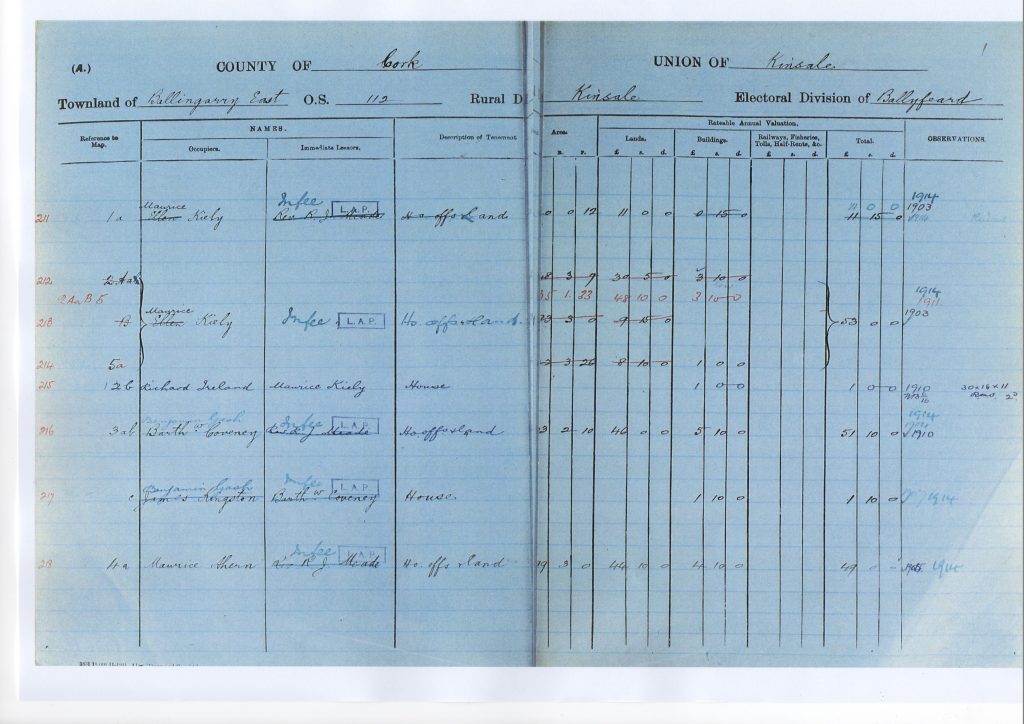Strictly speaking, “reverse genealogy” should mean searching out your distant descendants. Good luck with that.
 What it usually means is sideways-and-forward genealogy, taking collateral family and tracking them forward to trace living relatives. And that really is close to peering into the distant future. You’re going against the grain of time and causality: your ancestors’ records show what they had done, not what they were going to do. Crystal ball time.
What it usually means is sideways-and-forward genealogy, taking collateral family and tracking them forward to trace living relatives. And that really is close to peering into the distant future. You’re going against the grain of time and causality: your ancestors’ records show what they had done, not what they were going to do. Crystal ball time.
That much said, the appeal is obvious, especially to the descendants of those who left Ireland five or six generations ago. If you do manage to reconnect it can mean a whole new family and community to belong to, a wonderful thrill.

The producers of a genealogy TV show I once worked on were always hunting for that money shot, the revelation of family connections rediscovered, with the resultant outpouring of telegenic tears.
So it’s worth doing, and it can be done, but only with extra dollops of Irish genealogy’s two best friends, luck and persistence. Here are some of the main tools:
-
-
- Valuation Office Revision books: Griffith’s Primary Valuation is the greatest cadastral survey ever carried out in Europe. Its purpose was taxation, so it needed updating whenever the property occupier changed. In the 26 counties of the Republic, Griffith’s remained the basis of local tax up to the 1980s and 1990s and in Northern Ireland up to the 1930s. Which means there is a continuous record of every single property listed in the original published Griffith’s. Find someone in the 1850s in the Primary Valuation and there’s a good chance whoever is on the land now is connected, especially if the family were there when small-holders were subsidised to buy out their holdings between 1890 and 1914, a period conveniently framing the 1901 and 1911 censuses.
-
You can follow the changes decade by decade through the Valuation Revision Books (aka “Cancelled Books”). In the Republic the Books are still only available in the Valuation Office itself. Bring a copy of the Griffith’s page and a good camera(-phone). Sometimes the records can be hard to disentangle and having something to chew over at your leisure is vital. The LDS Family History Library also has microfilm copies.

Even if none of your people were from (what’s now) Northern Ireland, it’s still worth having a look at the marvellous job PRONI have done on their Revision Books. They understood perfectly that the usefulness of the Books is in the time-lapse picture of holdings and occupiers and have organised their online copies to make that clear. The pity is that they end in the 1930s. As my father used to say, God never opens a door but he closes a window.
-
-
- GRO records: The other major sources are the civil registration records at IrishGenealogy.ie. Through them you can find marriages for those who stayed behind and then their children births and their children’s marriages and their children’s children’s’ children … Not that simple, of course, but there are plenty of workarounds. Use the Revision Books to get prima facie evidence of inheritance which might lead to a will. Use marriage indexes on other sites that include fathers’ names – rootsireland, FamilySearch, FindMyPast. Skip forward to 1901 and 1911 to see if there’s any evidence of extended family in the same area. Concentrate on more distant relatives with prominent names or occupations.
-
Just don’t try any of this with a Murphy.
If you do manage to reconnect, you can expect a much warmer welcome than forty years ago. Then, people here were wary of Yanks turning up on the doorstep, asking awkward questions about the plot of land left to their Grand-uncle Paddy that no-one in Ireland ever bothered to tell him about. We’ve chilled a bit. Now that the statute of limitations has run out.
More on records for living relatives next time. If you’d like to see a walkthrough of one case, there’s one in this week’s YouTube video.
John – As a McLaughlin it would have been almost as hard a search as a Murphy…and many of our mass of cousins in the US and Canada wrote either Ireland or Donegal as our point of derivation…The U S citizenship records are a great source of accidental information…My great grandfather indicated that he was from Magheragart, Ireland…the worldly farmer that he was…It took a little searching on the internet……..and once found that it was in Dromore, Tyrone…we checked out all your mentioned Irish sources…and found that Magheragart and its surrounding townlands were infested with McLaughlins and Slevins…my great great grandmother was a Slevin…looking at the Magheragart townland map we found the land my great great grandmother owned by her married name…thereupon we contacted the present owners my 3rd cousins…and now I have more McLaughlin and Slevin cousins in Ireland than the USA…..We have now Y DNAed the McLaughlins and Slevins in Dromore…both are unique…and McLaughlins and Slevins around the world can now Y DNA themselves and find their roots in the radius of Dromore, Tyrone…and their distance from Dromore by miles and DNA strength…
We have also checked the maternal DNAs and autosomal Ancestry.com DNAs of men and women..
Many of us who had moved on to Monaghan and elsewhere in Ireland because of the evictions after the first set of leases came up are closer to one Dromore line than another…and some who use Moville or Malin Head as their home in Ireland…end up finding their family in the parish records of St Dympna’s in Dromore…etc…
By DNA we are related to the Monaghan derived family of the blind coal miner Felix Slavin…who mined first in England before being crushed to death in Pennsylvania…
So be brave…whether you live in Ireland or elsewhere… and search USA, CN and AUS records for clues and back them up with DNA when you have found a pot of gold..
Great family story!
Those revision books are amazing. There are several ways they can help.
If a woman becomes occupier, it is usually because her husband has died, and this can give you her name.
A change in occupation usually means a death, giving you a strong clue where to look for a death record.
If the map looks like a jigsaw of interconnected pieces of land, especially if the pieces converge on a cluster of houses and seem to share them, you have a strong clue that the occupiers are related.
Tied in with this is that the old maps are so accurate, and many field boundaries unchanged, that you can often lay the Griffith map precisely over a satellite photo to locate a house exactly. And PRONI has several of these old maps at different dates so you can see the evolution of an area back to the 1830s.
For me, these property records are a unique treasure.
Where do I find the maps?????
http://www.askaboutireland.ie/griffith-valuation/
for Michael Carragher. Thank you so much for pointing me back to this page. I knew I was missing something that was probably very obvious and now have fun access to what might be life changing information .
thanks
alan turley
I’m wondering if there was an age at which a young man in Ireland in the 19th century would have been considered old enough to be considered a land holder and therefore listed in Griffiths? At least 18, but could a land holder be younger than that?
Thanks for all your work—it’s a tremendous help!